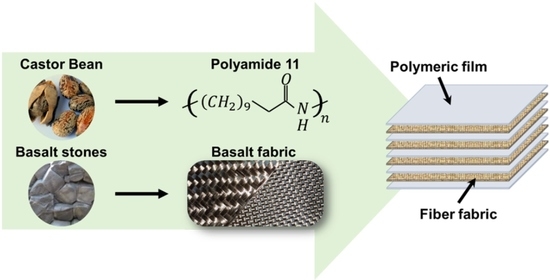Flexural Properties and Low-Velocity Impact Behavior of Polyamide 11/Basalt Fiber Fabric Laminates
Abstract
:1. Introduction
2. Materials and Methods
2.1. Materials
2.2. Composite Fabrication
2.3. Experimental Techniques
3. Results and Discussion
3.1. Flexural Properties
3.2. Low-Velocity Impact Behavior
3.3. Morphological Analysis
- •
- Regardless of the type of architecture of the reinforcement fabric, the plasticized matrix P40 wraps the reinforcement fibers better than the not-plasticized PA11 TL grade.
- •
- On the other hand, with the same type of matrix, the twill fabric guarantees a better interfacial interaction than the plain architecture. Moreover, an indirect indication of a better impregnation achieved in the twill samples is provided by the lower polymeric matrix presence between the layers. In this case, the polyamide 12 flows more easily in the fiber bundles due to the fabric’s architecture.
4. Conclusions
Author Contributions
Funding
Conflicts of Interest
References
- Asadi, A.; Baaij, F.; Mainka, H.; Rademacher, M.; Thompson, J.; Kalaitzidou, K. Basalt fibers as a sustainable and cost-effective alternative to glass fibers in sheet molding compound (SMC). Compos. Part B Eng. 2017, 123, 210–218. [Google Scholar] [CrossRef]
- Subramanian, R.V.; Austin, H.F. Silane coupling agents in basalt-reinforced polyester composites. Int. J. Adhes. Adhes. 1980, 1, 50–54. [Google Scholar] [CrossRef]
- Fiore, V.; Scalici, T.; Di Bella, G.; Valenza, A. A review on basalt fiber and its composites. Compos. Part B Eng. 2015, 74, 74–94. [Google Scholar] [CrossRef]
- Russo, P.; Papa, I.; Pagliarulo, V.; Lopresto, V. Polypropylene/basalt fabric laminates: Flexural properties and impact damage behaviour. Polymers 2020, 12, 1079. [Google Scholar] [CrossRef] [PubMed]
- Sang, L.; Zheng, G.; Hou, W.; Yang, X.; Wei, Z. Crystallization and mechanical properties of basalt fiber-reinforced polypropylene composites with different elastomers. J. Therm. Anal. Calorim. 2018, 134, 1531–1543. [Google Scholar] [CrossRef]
- Adole, O.; Anguilano, L.; Minton, T.; Campbell, J.; Sean, L.; Valisios, S.; Tarvedi, K. Basalt fibre-reinforced high density polyethylene composite development using the twin screw extrusion process. Polym. Test. 2020, 91, 106467. [Google Scholar] [CrossRef]
- Mazur, K.; Jakubowska, P.; Romanska, P.; Kuciel, S. Green high density polyethylene (HDPE) reinforced with basalt fiber and agricultural fillers for technical applications. Compos. Part B Eng. 2020, 202, 108399. [Google Scholar] [CrossRef]
- Song, J.; Liu, J.; Zhang, Y.; Chen, L.; Zhong, Y.; Yang, W. Basalt fibre-reinforced PA1012 composites: Morphology, mechanical properties, crystallization behaviours, structure and water contact angle. J. Compos. Mater. 2015, 49, 415–424. [Google Scholar] [CrossRef]
- Yu, S.; Hwang, J.Y.; Hong, S.H. 3D microstructural characterization and mechanical properties determination of short basalt fiber-reinforced polyamide 6,6 composites. Compos. Part B Eng. 2020, 187, 107839. [Google Scholar] [CrossRef]
- Kracalic, M.; Pospisil, L.; Slouf, M.; Mikesova, J.; Sikora, A.; Simonik, J.; Fortenly, I. Recycled poly (ethylene terephthalate) reinforced with basalt fibres: Rheology, structure, and utility properties. Polym. Compos. 2008, 29, 437–442. [Google Scholar] [CrossRef]
- Yin, Y.; Deng, P.; Zhang, W.; Xing, Y. Effect of enhanced γ-irradiation on the compatibility of polyethylene terephthalate-based basalt fibre-reinforced composites. Adv. Polym. Technol. 2018, 37, 3376–3383. [Google Scholar] [CrossRef]
- Sang, L.; Han, S.; Li, Z.; Yang, X.; Hou, W. Development of short basalt fiber reinforced polylactide composites and their feasible evaluation for 3D printing applications. Compos. Part B Eng. 2019, 164, 629–639. [Google Scholar] [CrossRef]
- Barczewski, M.; Mysiukiewicz, O.; Matykiewicz, D.; Klozinski, A.; Andrzejewski, J.; Piasecki, A. Synergistic effect of different basalt filler and annealing on the structure and properties of polylactide composites. Polym. Test. 2020, 89, 106628. [Google Scholar] [CrossRef]
- Deak, T.; Czigany, T.; Marsalkova, M.; Militky, J. Manufacturing and testing of long basalt fibre reinforced thermoplastic matrix composites. Polym. Eng. Sci. 2010, 50, 2448–2456. [Google Scholar] [CrossRef]
- Prajapati, R.S.; Jain, S.; Shit, S.C. Development of basalt fiber-reinforced thermoplastic composites and effect of PE-g-MA on composites. Polym. Compos. 2015, 38, 2798–2805. [Google Scholar] [CrossRef]
- Lee, W.T.; Lee, S.; Park, S.-M.; Lee, D. Mechanical, Thermomechanical, and local anisotropy analyses of long basalt fiber reinforced polyamide 6 composites. Compos. Struct. 2019, 222, 110917. [Google Scholar] [CrossRef]
- Yu, S.; Oh, K.H.; Hong, S.H. Enhancement of the mechanical properties of basalt fibre-reinforced polyamide 6,6 composites by improving interfacial bonding strength through plasma polymerization. Compos. Sci. Technol. 2019, 182, 107756. [Google Scholar] [CrossRef]
- Deak, T.; Czigany, T.; Tamas, P.; Nemeth, C. Enhancement of interfacial properties of basalt fiber reinforced nylon 6 matrix composites with silane coupling agents. Express Polym. Lett. 2010, 4, 590–598. [Google Scholar] [CrossRef]
- Batista, N.L.; Olivier, P.; Bernhart, G.; Rezende, M.C.; Cocchieri Botelho, E. Correlation between degree of crystallinity, morphology and mechanical properties of PPS/carbon fiber laminates. Mater. Res. 2016, 19, 195–201. [Google Scholar] [CrossRef] [Green Version]
- Chadwick, A.R.; Kotzur, K.; Nowotny, S. Moderation of thermoplastic composite crystallinity and mechanical properties through in situ manufacturing and post-manufacturing tempering: Part 1—Mechanical characterization. Compos. Part A 2021, 143, 106286. [Google Scholar] [CrossRef]
- Taketa, I.; Kalinka, G.; Gorbatikh, L.; Lomov, S.V.; Verpoest, I. Influence of cooling rate on the properties of carbon fibre unidirectional composites with polypropylene, polyamide 6, and polyphenylene sulphide matrices. Adv. Compos. Mat. 2020, 29, 101–113. [Google Scholar] [CrossRef]
- Batista, N.L.; Agagnostopoulos, K.; Cocchieri Botelho, E.; Kim, H. Influence of crystallinity on interlaminar fracture toughness and impact properties of polyphenylene sulfide/carbon fiber laminates. Eng. Fail. Anal. 2021, 119, 104976. [Google Scholar] [CrossRef]
- Mahato, B.; Babarinde, V.O.; Abaimov, S.G.; Lomov, S.V.; Akhatov, I. Interface strength of glass fibers in Polypropylene: Dependance on the cooling rate and the degree of crystallinity. Polym. Compos. 2020, 41, 1310–1322. [Google Scholar] [CrossRef]
- Nielsen, A.S.; Pyrz, R. Study of the influence of thermal hystory on the load transfer efficiency and fibre failure in carbon/polypropylene microcomposites using Raman spectroscopy. Compos. Interfaces 1998, 6, 467–482. [Google Scholar] [CrossRef]
- Ye, L.; Scheuring, T.; Friedrich, K. Matrix morphology and fiber pull-out strength of T700/PPS and T700/PET thermoplastic composites. J. Mater. Sci. 1995, 30, 4761–4769. [Google Scholar] [CrossRef]
- Woigk, W.; Fuentes, C.A.; Rion, J.; Hegemann, D.; van Vuure, A.W.; Kramer, E.; Dransfeld, C.; Masania, K. Fabrication of flax-reinforced cellulose proprionate thermoplastic composites. Compos. Sci. Technol. 2019, 183, 107791. [Google Scholar] [CrossRef]
- Oksman, K.; Skrifvars, M.; Selin, J.-F. Natural fibres as reinforcement in polylactic acid (PLA) composites. Compos. Sci. Technol. 2003, 63, 1317–1324. [Google Scholar] [CrossRef]
- Russo, P.; Simeoli, G.; Vitiello, L.; Filippone, G. Bio-polyamide 11 hybrid composites reinforced with basalt/flax interwoven fibres: A tough green composite for semi-structural applications. Fibers 2019, 7, 41. [Google Scholar] [CrossRef] [Green Version]
- Oliver-Ortega, H.; Mendez, J.A.; Reixach, R.; Espinach, F.X.; Ardanuy, M.; Mutje, P. Towards more sustainable material formulations: A comparative assessment of PA11-SGW flexural performance versus oil-based composites. Polymers 2018, 10, 440. [Google Scholar] [CrossRef] [Green Version]
- Harizi, W.; Kaidi, S.; Monnin, A.; El Hajj, N.; Aboura, Z.; Benzeggagh, M. Study of the dynamic response of polymer-matrix composites using an innovative hydraulic crash machine. J. Dyn. Behav. Mater. 2015, 1, 359–369. [Google Scholar] [CrossRef] [Green Version]
- Labaupin, Y.; Hoang, T.Q.; Chauvin, M.; Touchard, F. Influence of the stacking sequence on the low-energy impact of flax/PA11 composite. J. Compos. Mater. 2019, 53, 3187–3198. [Google Scholar] [CrossRef]
- Armioun, S.; Panthapulakkal, S.; Scheel, J.; Tjong, J.; Sain, M. Biopolyamide hybrid composites for high performance applications. J. Appl. Polym. Sci. 2016, 133, 43595. [Google Scholar] [CrossRef]
- Houskyar, S.; Shanks, A.R.; Hodzica, A. Influence of Different Woven Geometry in Poly(propylene) Woven Composites. Macromol. Mater. Eng. 2005, 290, 45–52. [Google Scholar] [CrossRef]
- Caminero, M.A.; Rodriguez, G.P.; Chacon, J.M.; Garcia-Moreno, I. Tensile and flexural damage response of symmetric angle-ply carbon fibre-reinforced epoxy laminates: Non-linear response and effects of thickness and ply-stacking sequence. Polym. Compos. 2019, 40, 3678–3690. [Google Scholar] [CrossRef]
- Shys, T.-W.; Pan, Y.-H. Impact resistance and damage characteristics of composite laminates. Compos. Struct. 2003, 62, 193–203. [Google Scholar]
- Saadati, Y.; Chatelain, J.-F.; Lebrun, G.; Beauchamp, Y.; Bocher, P.; Vanderesse, P. A study of the interlaminar fracture toughness of unidirectional flax/epoxy composites. J. Compos. Sci. 2020, 4, 66. [Google Scholar] [CrossRef]
- Ratim, S.; Bonnia, N.N.; Surip, S.N. The effect of woven and non-woven fiber structure on mechanical properties polyester composite reinforced kenaf. In AIP Conference Proceedings 2nd; American Institute of Physics: College Park, MD, USA, 2012; Volume 1455, pp. 131–135. [Google Scholar]
- Lopresto, V.; Caprino, G.; Langella, A.; Leone, C. Penetration and indentation on basalt fibre reinforced plastic laminates under low velocity impacts. In Proceedings of the 15th European Conference on Composite Materials, Venice, Italy, 24–28 June 2012. [Google Scholar]
- Caprino, G.; Lopresto, V.; Langella, A.; Leone, C. Damage and energy absorption in GFRP laminates impacted at low velocity: Indentation model. Proc. Eng. 2011, 10, 2298–2311. [Google Scholar] [CrossRef] [Green Version]
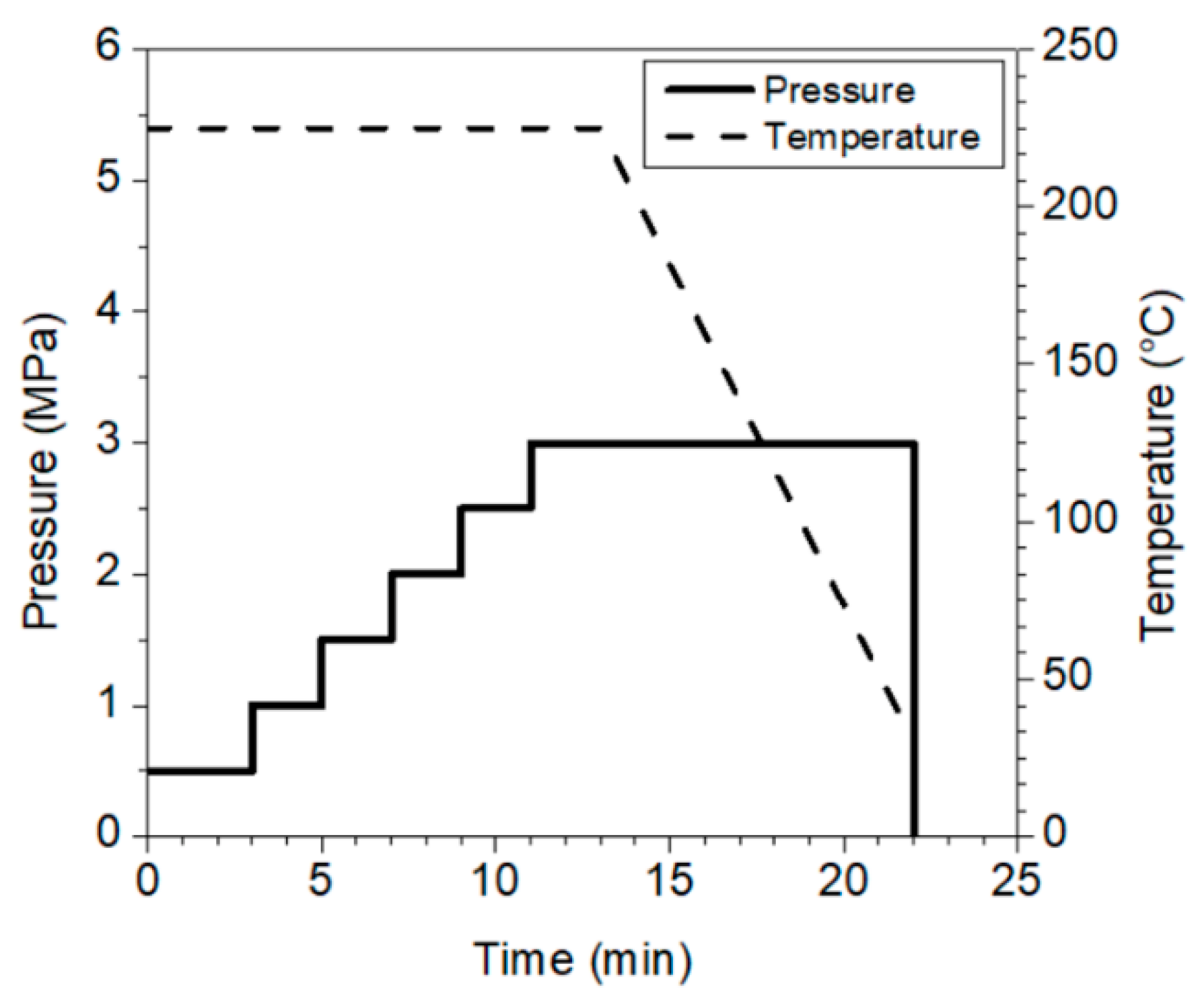
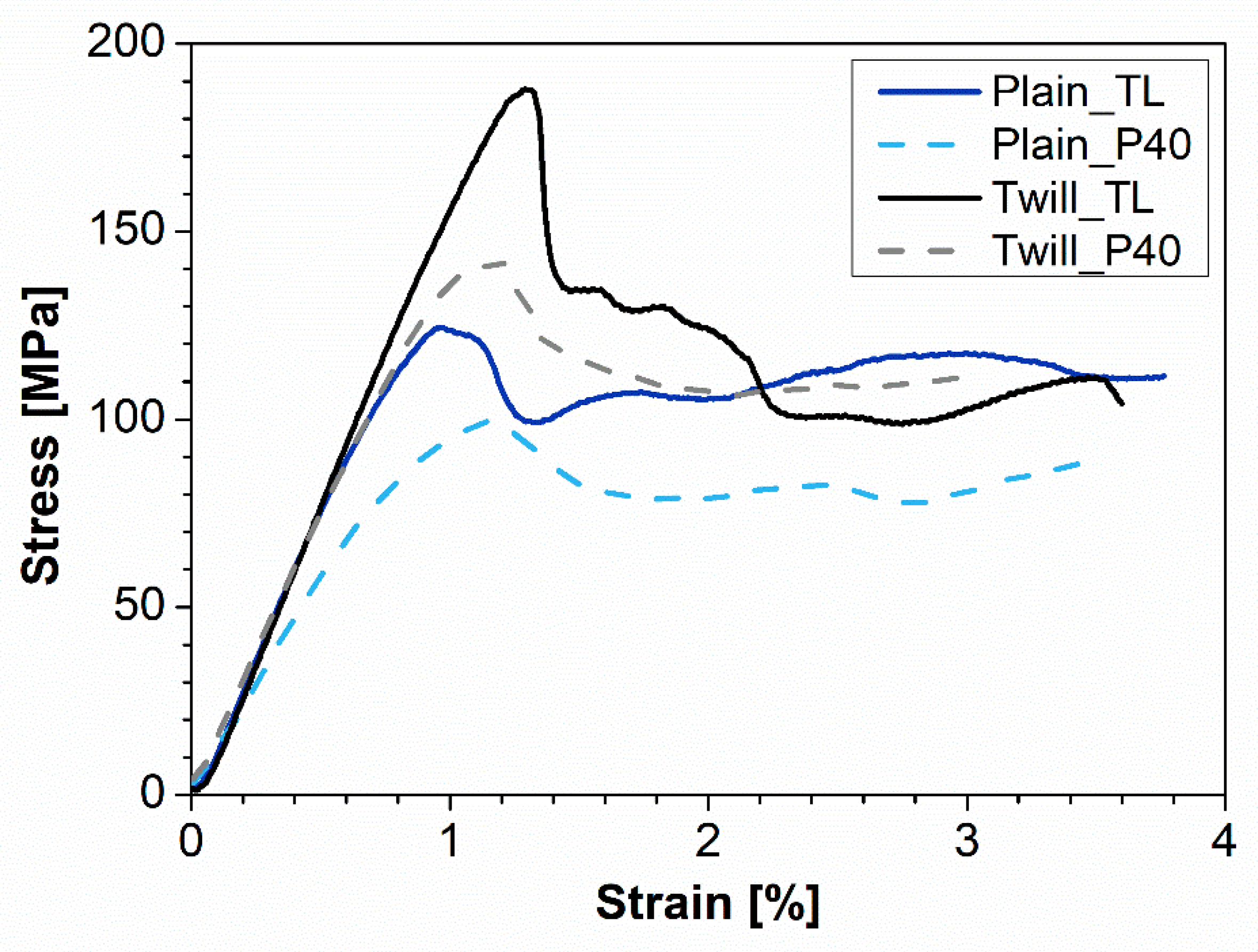
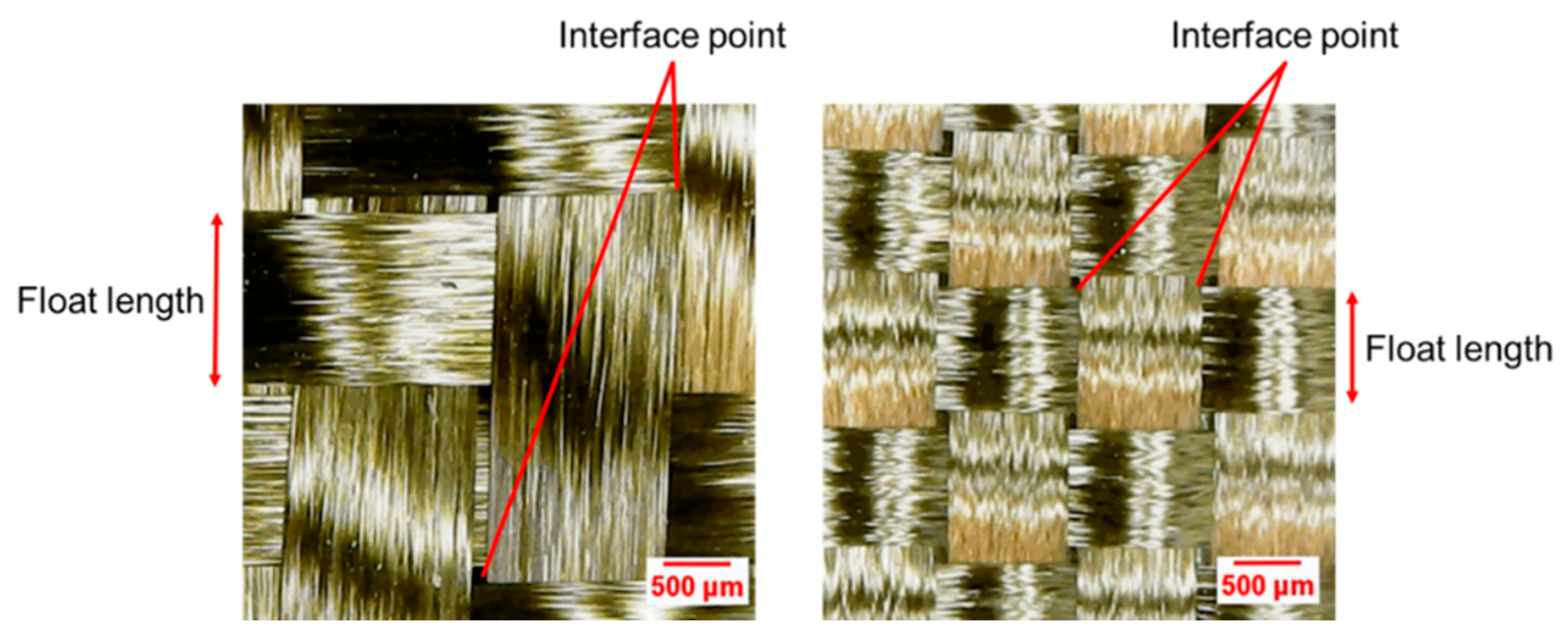

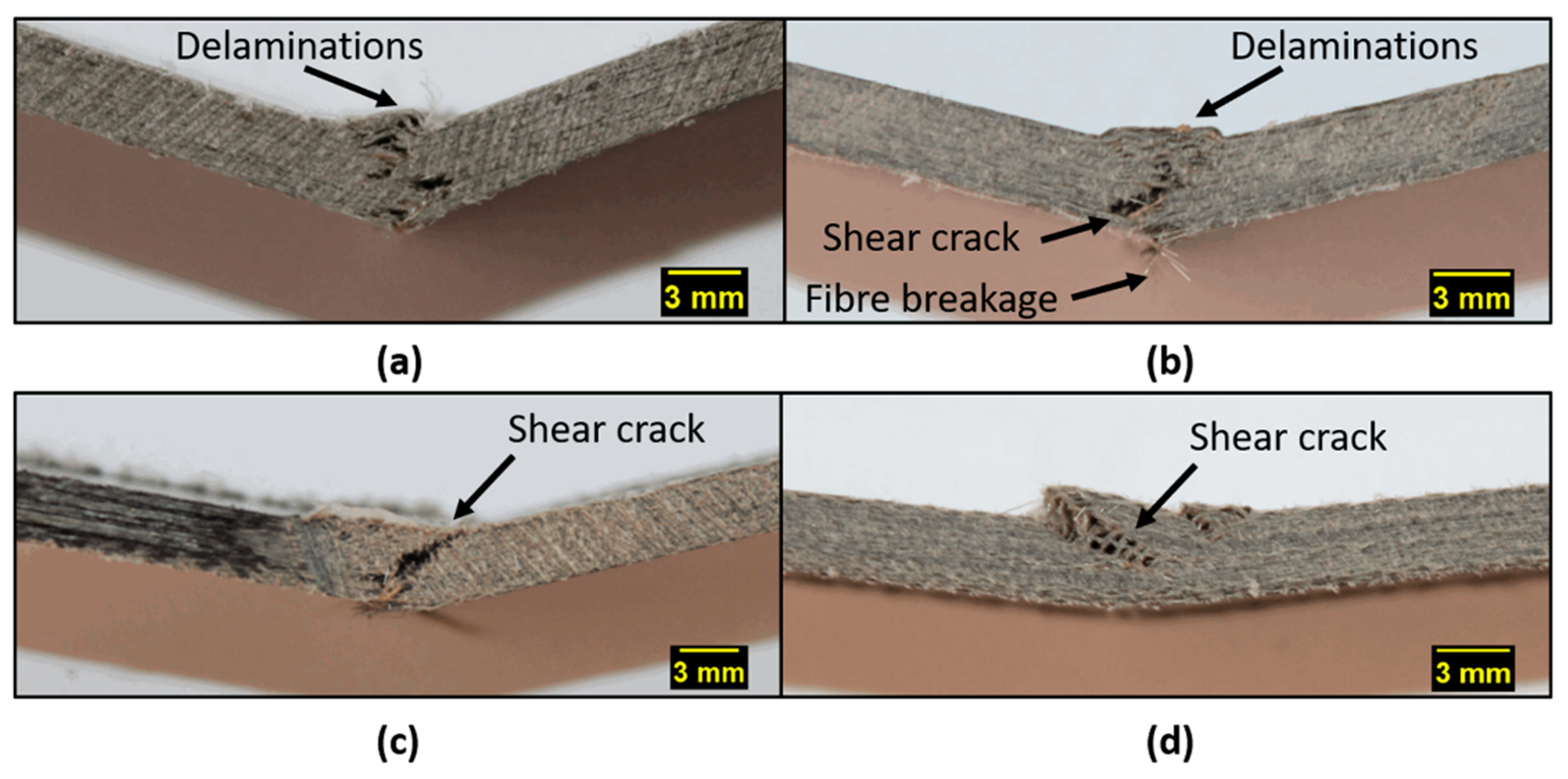
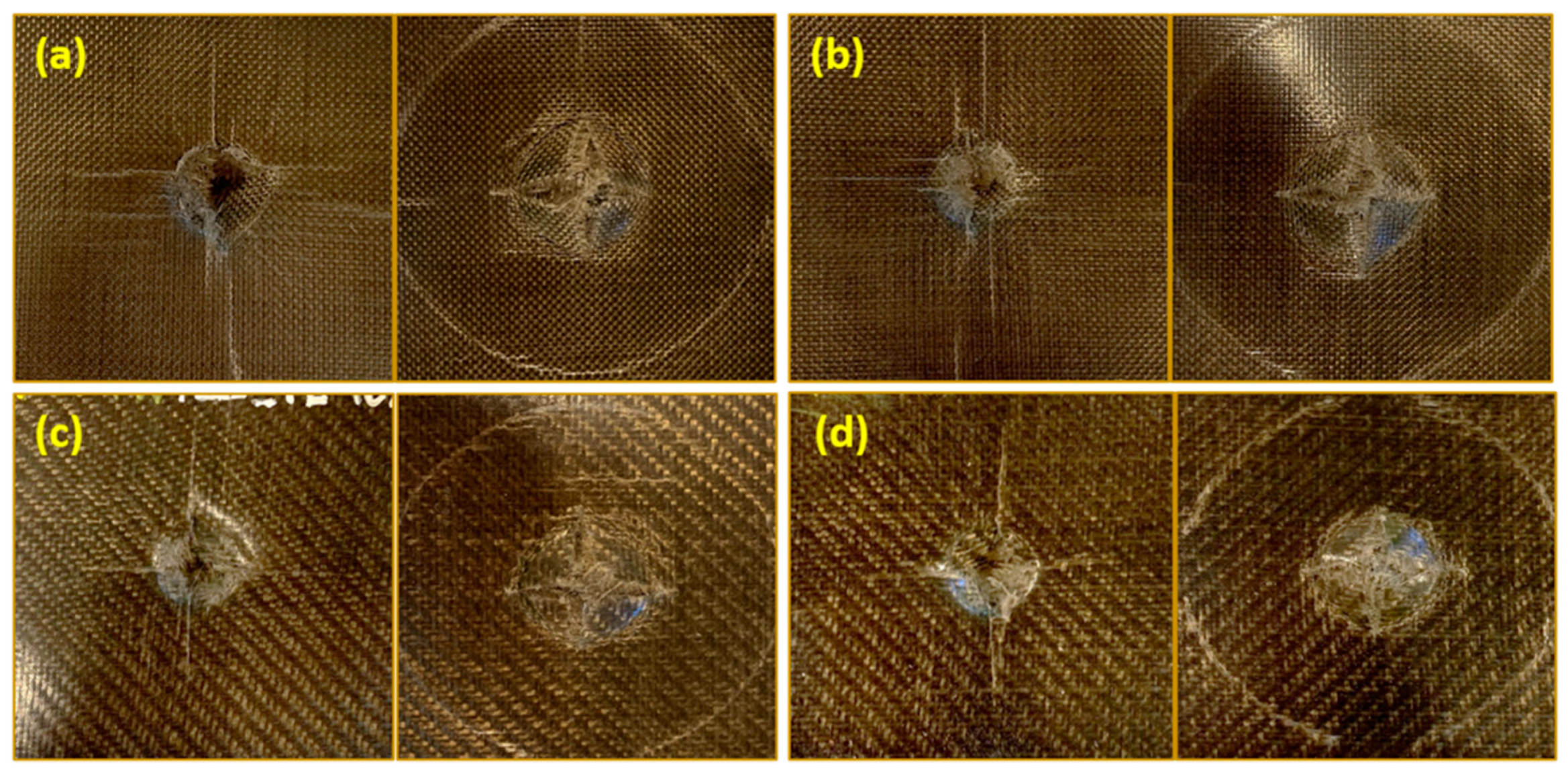


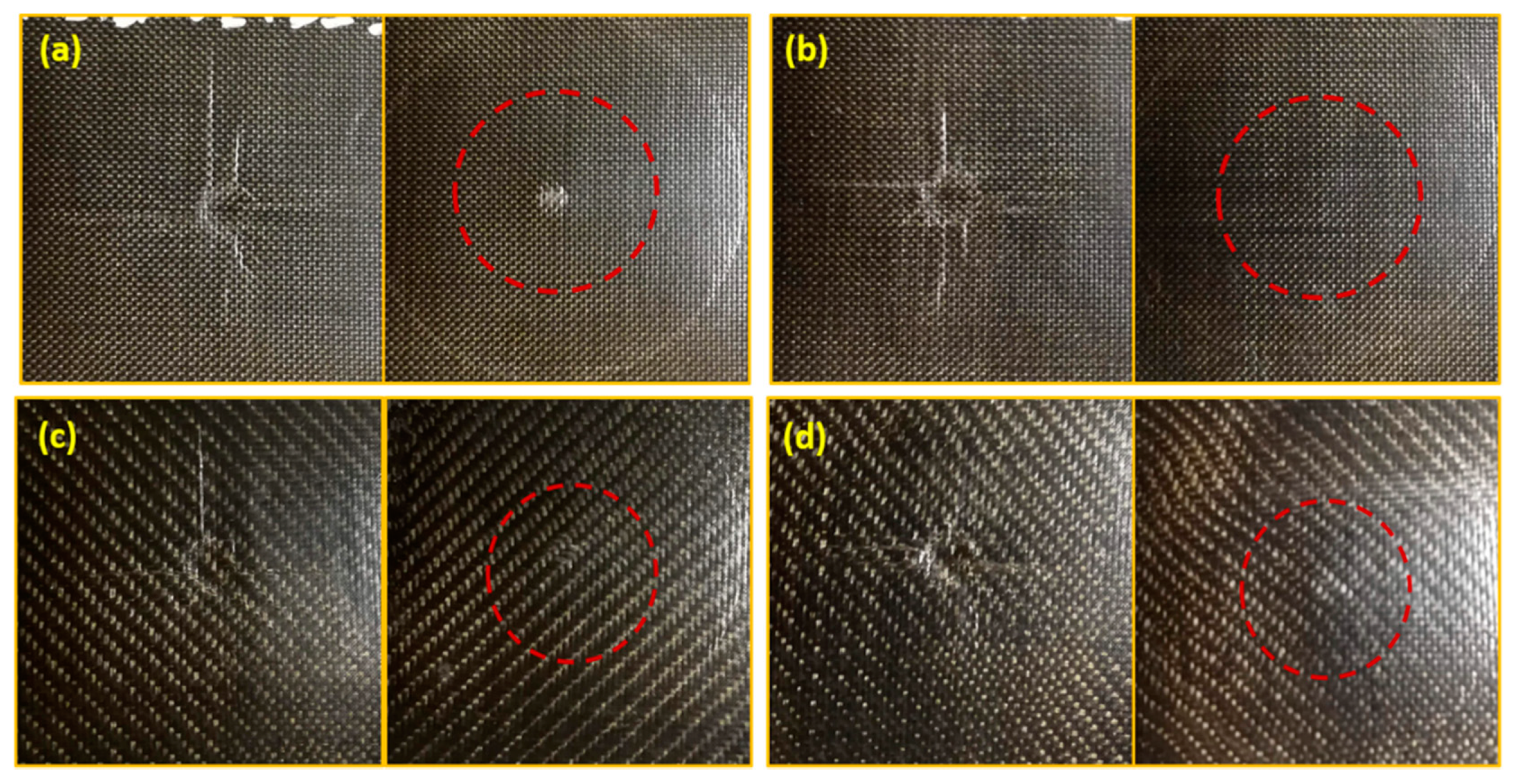

| Sample Type | Ef [GPa] | σf [MPa] |
|---|---|---|
| Plain_TL | 12.8 (1.8) | 124 (17) |
| Plain_P40 | 11.0 (1.2) | 91.5 (12) |
| Twill_TL | 15.7 (1.1) | 174 (25) |
| Twill_P40 | 14.8 (1.0) | 140 (19) |
| Sample Type | Fmax [N] | d [mm] | Up [J] |
|---|---|---|---|
| Plain_TL | 9464 (200) | 14.1 (2.5) | 131.6 (10.5) |
| Plain_P40 | 9189 (100) | 16.4 (0.9) | 152.2 (4.5) |
| Twill_TL | 8680 (176) | 12.2 (1.7) | 106.7 (12.3) |
| Twill_P40 | 9797 (185) | 14.8 (2.1) | 132.9 (14.0) |
| Sample Type | U [J] | Fmax [N] | d [mm] |
|---|---|---|---|
| Plain_TL | 10 | 3592 (85) | 4.3 (0.9) |
| 20 | 5074 (78) | 6.6 (0.5) | |
| 30 | 6165 (77) | 8.5 (1.0) | |
| Plain_P40 | 10 | 2934 (120) | 5.6 (1.2) |
| 20 | 4197 (100) | 9.4 (1.5) | |
| 30 | 5016 (95) | 11.4 (0.9) | |
| Twill_TL | 10 | 3807 (84) | 4.1 (0.6) |
| 20 | 5035 (80) | 6.6 (0.8) | |
| 30 | 6296 (66) | 8.5 (0.5) | |
| Twill_P40 | 10 | 3259 (95) | 4.6 (0.6) |
| 20 | 4911 (90) | 6.7 (0.5) | |
| 30 | 5558 (60) | 9.1 (0.2) |
Publisher’s Note: MDPI stays neutral with regard to jurisdictional claims in published maps and institutional affiliations. |
© 2021 by the authors. Licensee MDPI, Basel, Switzerland. This article is an open access article distributed under the terms and conditions of the Creative Commons Attribution (CC BY) license (http://creativecommons.org/licenses/by/4.0/).
Share and Cite
Vitiello, L.; Russo, P.; Papa, I.; Lopresto, V.; Mocerino, D.; Filippone, G. Flexural Properties and Low-Velocity Impact Behavior of Polyamide 11/Basalt Fiber Fabric Laminates. Polymers 2021, 13, 1055. https://doi.org/10.3390/polym13071055
Vitiello L, Russo P, Papa I, Lopresto V, Mocerino D, Filippone G. Flexural Properties and Low-Velocity Impact Behavior of Polyamide 11/Basalt Fiber Fabric Laminates. Polymers. 2021; 13(7):1055. https://doi.org/10.3390/polym13071055
Chicago/Turabian StyleVitiello, Libera, Pietro Russo, Ilaria Papa, Valentina Lopresto, Davide Mocerino, and Giovanni Filippone. 2021. "Flexural Properties and Low-Velocity Impact Behavior of Polyamide 11/Basalt Fiber Fabric Laminates" Polymers 13, no. 7: 1055. https://doi.org/10.3390/polym13071055





